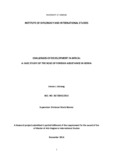| dc.description.abstract | Foreign assistance is among the policy tools in International Politics and Diplomacy that developed countries use to help African countries to address their challenges in sustainable development, amidst the reality that aid to poorest countries is declining, stagnating or shifting allocation priorities in favour of middle income level countries. Many scholars have difficulty in finding a nexus between aid, growth and development, as the debate rages on whether foreign assistance has any impact, as Africa is caught up in poverty trap and remains behind the developing world, in spite of the massive foreign assistance support which is hailed as the solution to World poverty. However, there is strong thinking that foreign assistance works, where there are proper institutions of governance and leadership. The tools used in data collection in this study, included interview schedules, document reviews, and internet. Purposive sampling was used to identify key informants such as officials from the line Ministries and development partners. The targeted population comprised line Ministries, SAGAS and development partners. Analysis was done using frequency distributions, cross tabulations and weighted average measures, using Ms Excel and results put into descriptive statistics to present views of Government officers and development partners. The major findings of the study are that the challenges of development in Africa can be classified into political, social, economic and environment, and that foreign assistance has increased over the last 10 years, despite the raging debates on the impact. Measuring the impact of foreign assistance is not easy, because all conclusions on its effect economic growth are contestable. The study will be useful to the development practitioners both at national and county level who are involved in implementing Kenya‟s Vision 2030, SDGs and Agenda 2063, and forms the basis for further research on how major development challenges can be overcome by strengthening foreign assistance, especially by the recipient and the donor. Some of the key recommendations include, Strengthening Leadership and Governance institutions, Growth Focused Policies and Implementation, Optimal utilization of the available resources and complementing foreign assistance with Aid for Trade. | en_US |



